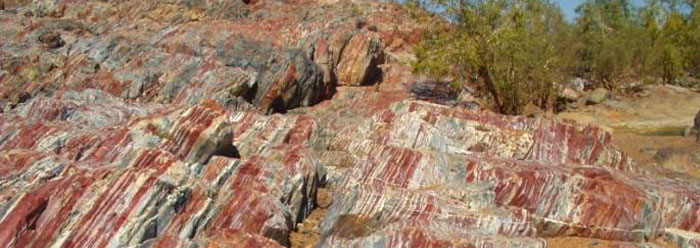Every year brings new scientific discoveries that shed light on the past. The Institute for Creation Research is dedicated to the study of origins from a biblical perspective, and ICR News has compiled what we consider to be the top 4 findings related to origin studies from the stories we reported in 2009. The previous installments featured paleontology and biological evolution. This one examines geology and will be followed by cosmology.
Earth Materials Found to Fit the Creation Account
Charles Darwin’s revolutionary theory was sparked by belief in deep time. When he saw the Santa Cruz River valley, he mistakenly decided that its formation reflected gradual processes acting over long ages.1 He later applied this concept to the life forms he observed in the Galapagos, and gradualistic Darwinism was born.
Science has yet to offer any verification for uniformitarianism, an evolutionary origin for life, or deep time, and geological studies in 2009 undermined them even further.
One study closely matched tiny ripples in shales with those formed in fast-flowing sediment flume studies. Evolution claims that shales and the other mud rocks—like mudstone and limestone, which form the majority of earth’s continental crust—were made by a slow and gradual process of silt accumulation at the bottom of shallow oceans or lake beds. But the fast-flowing fluid deposition evidence presents a remarkable departure from standard gradualist geology, and it is what catastrophist geologists would expect to find.2
Earth’s early atmosphere has presented a puzzle to those who believe that life developed through natural processes. Since oxygen is lethal to the host of chemicals found inside living cells, evolutionary scientists hypothesize that the atmosphere could not have contained oxygen when life first emerged. Only then could the chemicals for life have been protected from oxidation long enough to come together and form the first cell.
But the absence of oxygen would also mean the absence of an ozone layer, which is necessary to protect those same chemicals on earth’s surface from harmful solar radiation. Evolutionists are no closer to solving this contradiction, and their task was made more difficult when rock-solid evidence emerged last year that the earliest rocks on earth had formed amidst plenty of oxygen.3
In a blow to assumptions of deep time, a relatively obscure study found evidence that a natural process called “cavitation,” which is very powerful at the microscopic level, had dramatically accelerated the decay rate of a radioactive element.4 The sun also altered the rate of radioactive decay in several measured nuclear systems. These findings ought to cause scientists to consider that radioactive decay processes may be invalid time clocks for dating geologic materials.
An earth crust shaped by catastrophic forces, oxygen present when the lowermost sedimentary rocks formed, and flexible radioactive decay rates do not fit with big-picture evolution. They do, however, dovetail with the biblical account of a special, recent creation and a global flood.5
References
- Austin, S. A. 2009. Darwin's First Wrong Turn. Acts & Facts. 38 (2): 26.
- Thomas, B. Flumes Zoom in on Mud Rock History. ICR News. Posted on icr.org July 24, 2009, reporting on research published in Scheiber, J., and Z. Yawar. 2009. A New Twist on Mud Deposition – Mud Ripples in Experiment and Rock Record. The Sedimentary Record. 7 (2): 4-8.
- Thomas, B. Ancient Oxygen-Rich Rocks Confound Evolutionary Timescale. ICR News. Posted on icr.org April 8, 2009, reporting research published in Hoashi, M. et al. 2009. Primary haematite formation in an oxygenated sea 3.46 billion years ago. Nature Geoscience. 2 (4): 301-306.
- Thomas, B. Radioactive Decay Rates Not Stable. ICR News. Posted on icr.org August 5, 2009, reporting on research published in Cardone, F., R. Mignani R. and A. Petrucci. 2009. Piezonuclear decay of thorium. Physics Letters A. 373 (22): 1956-1958.
- For more information on decay rates, see Humphreys, D. R. 2003. New RATE Data Support a Young World. Acts & Facts. 32 (12).
Image Credit: Hiroshi Ohmoto/Yumiko Watanabe
* Mr. Thomas is Science Writer at the Institute for Creation Research.
Article posted on January 7, 2010.






















